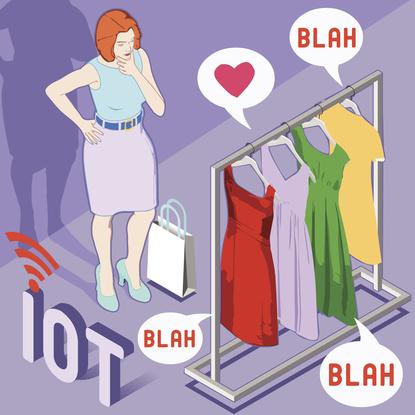How the Internet of Things is revolutionizing retail
- 26 July, 2016 05:52

Throughout all industries, a majority of large companies (those with 1,000 employees or more) are using or planning to use IoT technologies, according to Forrester Research’s 2015 Global Business Technographics Networks and Telecommunications Survey. Those enterprises are hoping to gather data that can be leveraged to improve efficiency, serve customers better and gain insights into new ways of doing business.
But IoT technology is already reshaping and revolutionizing the retail industry, yielding advances and new opportunities in customer service, throughout the supply chain and in brick-and-mortar stores and other channels — including new venues that show a lot of promise, such as home-based connected platforms. Tech-savvy retailers looking to gain a competitive advantage are installing smart shelves that detect when inventory is low, RFID sensors that track goods throughout the supply chain, systems that send personalized digital coupons to shoppers when they enter the store, and sensors that monitor the quality of perishable items.
Changing the consumer experience with IoT
Today’s consumers expect their shopping experience to be seamless across every channel, whether it’s a brick-and-mortar store, an ecommerce site, a mobile app or even a phone call with customer service. IoT technologies offer an almost endless capacity for transforming the retail consumer experience, says Nayaki Nayyar, general manager and global head of IoT and Innovation Go to Market at SAP.
“We are already working with many leading retailers and consumer product companies to reimagine what a connected store could look like,” Nayyar says, citing everything from electronic shelf labels with dynamic pricing and self-checkout with smartphones to interactive digital signs that know who is in front of them and can tailor promotions to the individual. “We expect this to grow very fast in the next few years and completely change the consumer experience.”
[ Retail: 6 ways data is taking over retail ]
One technology that’s powering that potential is long-range, low-power Wi-Fi. “From a customer-facing perspective, Wi-Fi and other indoor location-based services technologies will allow retailers to bring IoT into the store in a way that makes sense,” says Dan Mitchell, a retail industry consultant at SAS. Those technologies, he explains, will allow retailers to more pervasively experiment with how IoT can improve the customer experience while respecting privacy. “The learning curve period is a critical stage in helping retailers understand the true value of sensor data to make better merchandising and marketing choices,” he adds.
Sending the supply chain soaring
In addition to potentially revolutionizing customer-facing applications, IoT technologies may play a big role in retail supply chain and delivery operations, says Gene Wojciechowski, former CIO of Walmart.com and current CIO at Newgistics, which provides ecommerce technology to top retailers and brands. “Retail is detail — they want to understand to the minutest detail where the goods are and how up-to-date they are,” he says. “The desire for information is insatiable, and IoT can provide some of that.”
Not only will IoT technology allow for better visibility, such as identifying within a 10-minute timeframe when goods will be delivered, it can also aid in loss prevention and be used to measure the impact of environmental factors, such as heat, on goods moving through the supply chain, he explains. Damages to goods can be recorded with the exact time and location of the damage, providing an audit trail to identify the responsible party, he says.
Automating and optimizing the supply chain is one of the key uses of IoT among retailers, adds Nayyar. “Everyone knows in advance not to run out of chocolate before Valentine’s Day or beer around the Super Bowl, but the real question is how to handle an unexpected surge in demand due to an unscheduled event,” she says. Getting this on-shelf availability right is possible with a highly responsive IoT-enabled supply chain system, shelf sensors in the stores and warehouse systems that automatically re-order products when inventories reach certain levels.
For tracking products, RFID tags and sensors are one of the most important IoT technologies to watch, according to Mitchell. “By using RFID, retailers can increase inventory accounting accuracy, dramatically reduce out-of-stocks and reduce product loss, all of which can result in margin growth,” he says. “And with an accurate real-time understanding of where inventory is located, retailers can make cost-based decisions on the fly to best fulfill customer needs across channels.”
IoT challenges for retailers — and the future journey
In business overall, the biggest challenge with the Internet of Things is the rapid evolution of the scope and variety of the technologies that can be used in connected ecosystems, says Mitchell, noting that it can be hard to “future-proof” investments when change is ongoing.
In retail specifically, the biggest immediate hurdle for companies to overcome is how to manage, analyze and act on the reams of data pouring in from all of the connected devices. “Simply capturing the data is a challenge all by itself,” he says. “But the retailer then has to distill and transform the data into usable information.”
[Related: Why data scientist is the hottest tech job in retail]
To quickly and accurately understand shopper behaviors, for example, high-performance analytics must be applied to the data to separate noise from meaningful signals. “Those insights need to then be connected to a decision management engine to orchestrate action – whether that means personalizing an in-store display or repositioning inventory in a warehouse,” Mitchell says.
The retail industry is at the beginning of the IoT journey, says Nayyar. And the important thing for merchants to recognize at this point is that the IoT isn’t just about sensors and connectivity — it’s really about business outcomes, such as creating new customer experiences, revenue streams and business models.
“The true transformation will come when you look outside the four walls of a retail store,” Nayyar says, “and build an end-to-end networked IoT strategy with your network of customers, suppliers, assets and extended ecosystem.”

